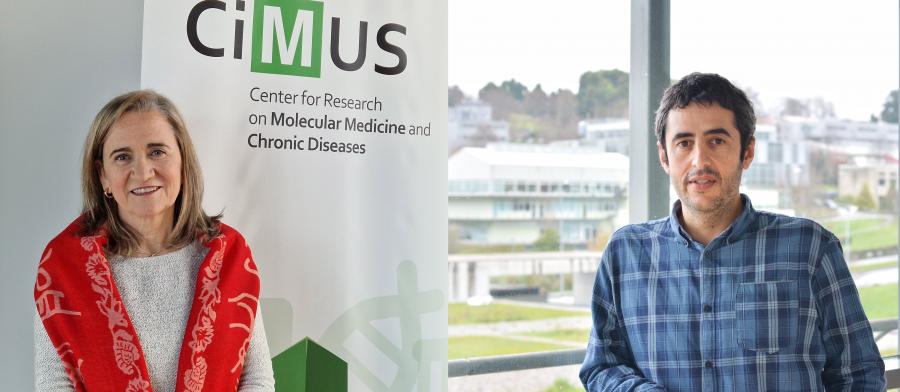USC CiMUS researchers advance in the early detection and treatment of lethal brain cancer thanks to nanotechnology
- The study opens the door to a completely new therapeutic approach and could lead to a clinical trial within three years.
- Through the USC's Sumo Valor platform, this research project can receive donations from institutions, companies or civil society to promote new advances.
Glioblastoma is a fast-growing and aggressive tumour originating in the brain that mainly affects older people. It is the most common brain tumour and currently has no cure. Now, USC CiMUS researchers led by María José Alonso and Pablo Aguiar are making progress in the early diagnosis and treatment of this disease thanks to nanotechnology within the framework of the USC's crowdfunding platform Sumo Valor, which seeks citizen participation to raise funds through donations. The research is part of the DIAGBI programme of the Ministry of Science and Innovation's R&D&I Projects in strategic lines of public-private collaboration.

Diagnostic and therapeutic nanotechnology
There is currently no treatment for this disease and the average survival is no more than 14 months from diagnosis. "This is because research has focused on other more prevalent types of cancer, such as breast, prostate or lung cancer. In the case of brain tumours, the lack of investment has meant that the prognosis of patients today is similar to what it was several decades ago," explains CiMUS principal investigator María José Alonso.
For this USC group, nanotechnology represents an enormous challenge in terms of bringing radiopharmaceuticals from intravenous injection to the glioblastoma. "Although, thanks to the monoclonal antibody, the radiopharmaceutical should bind specifically to the tumour, for this to happen it first has to get there. The great difficulty posed by our project and which we intend to solve with the development of nanoparticles that allow the radiopharmaceutical to cross the different biological barriers it encounters. The biggest challenge is in the brain, where it first has to overcome the blood-brain barrier and then in the brain until it reaches the tumour cells," says Alonso.
Field work
The work directed from the CiMUS of the USC has a first part of development in the laboratory, in which different formulations of nanoparticles will be tested and the optimal solution for crossing the blood-brain barrier will be sought. In addition, the antibodies will be tested for binding to radioactive isotopes to form the radiopharmaceutical. The first phase should result in several prototype nanoparticles capable of encapsulating the radiopharmaceuticals.
The second part of the work, according to CiMUS principal investigator Pablo Aguiar, "will focus on the in vivo validation of the prototypes". This will involve working with animal models of glioblastoma and state-of-the-art imaging equipment to test the efficacy in terms of diagnosis and treatment. "First, we will investigate whether our radiopharmaceuticals are able to reach the tumour in a specific way using PET imaging, and then we will test whether the electrons are able to kill tumour cells and control tumour growth," he says.
Clinical trial
The scientists are confident that their results will show an increase in animal survival compared to conventional chemotherapy-based treatments. The translational orientation of the experiments will make it possible to generate evidence that can be transferred to a clinical trial.
Progress in this line of research could lead to a paradigm shift in the treatment of glioblastoma and other difficult-to-diagnose cancers and significantly improve quality of life and life expectancy. If successful, "our research could generate the necessary evidence to be able to propose a clinical trial within three years," say María José Alonso and Pablo Aguiar.
DIAGBI Project
This study is part of the project "Early molecular nanoDIAGnostics of Brain tumors using ImmunePET (DIAGBI)" funded with more than 1.4 million euros within the call for R+D+i projects in strategic lines in public-private collaboration of the Ministry of Science and Innovation. DIAGBI seeks to develop a new technology that allows early diagnosis and non-invasive monitoring of the most aggressive brain tumours using immuno-PET techniques.
Coordinated by the CiMUS of the USC, it has the collaboration of three leading companies from Galicia in the development of biotechnological products such as Nasasbiotech S.L., Sunrock Biopharma SL and Qubiotech Health Intelligence S.L. and the entities Fundació Privada Institut d'Investigació Oncològica de Vall d'Hebron, the Fundación para la Investigación Biomédica del Hospital Universitario La Paz and the Fundació Hospital Universitari Vall d'Hebron - Institut de Recerca.
Social involvement in the advancement of science
This project, promoted by the CiMUS of the USC, is part of the SUMO Valor platform of the USC, the initiative with which the University of Compostela wants to promote interaction with society and create a meeting point that involves companies, institutions and civil society in the projects it develops in areas such as research, culture and sports. The study exemplifies the commitment of this platform to the development of science in fields such as biomedicine and healthcare.
Any individual or legal entity can make a micro-donation through this platform https://www.usc.gal/gl/usc/mecenado/sumo-valor. From the donor's point of view, in addition to direct participation in the research, this donation has tax advantages since, as it is for a research project, a tax deduction can be obtained.
Link to the video on youtube:
Nano-radiopharmaceuticals against glioblastoma. The most aggressive brain tumour
